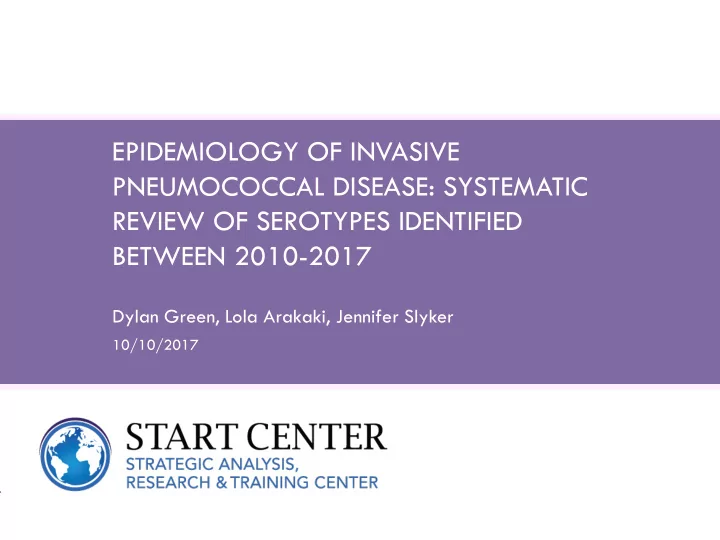

EPIDEMIOLOGY OF INVASIVE PNEUMOCOCCAL DISEASE: SYSTEMATIC REVIEW OF SEROTYPES IDENTIFIED BETWEEN 2010-2017 Dylan Green, Lola Arakaki, Jennifer Slyker 10/10/2017 Pneumo Epi of IPD | All Results as of October 10, 2017
Systematic Review of IPD Serotypes Objectives and Methods Objective To conduct a systematic review of pneumococcal serotypes identified in cases of invasive pneumococcal disease (IPD) among persons of all age since 2010, to inform the potential next generation of Pneumococcal vaccines Sources Published primary literature Utilized search terms from previously published systematic reviews Expanded age ranges to include individuals >5 years old International Symposium on Pneumococci & Pneumococcal Diseases (2014, 2016) BMGF Collaborators [unpublished data] Publicly available surveillance data Inclusion Criteria Serotype counts or incidence, published after 2010, and isolates from sterile sites Pneumo Epi of IPD 1/16/2018 | 2 All Results as of October 10, 2017
Systematic Review of IPD Serotypes Data Sources for IPD Systematic Review Screened out by abstract (n – 883) Abstracts Screened (n – 1,151) Pre-2010 (n – 402) • No serotype data (n – 226) • Not IPD (n – 111) • Non-sterile sites (n – 100) Full Length Articles Reviewed • Other (n – 44) Screened out (n – 173) • (n – 268) Pre-2010 (n – 65) • No serotype data (n – 29) • Non-sterile sites (n – 28) • Public Surveillance Duplicates (n – 37) • Included and Abstracted Data (n – 6) Other (n – 14) • (n – 95) BMGF Collaborators (n – 5) Total Sources Included in Analysis ISPPD (n – 109) (n – 3) 172,564 Isolates Pneumo Epi of IPD 1/16/2018 | 3 All Results as of October 10, 2017
Systematic Review of IPD Serotypes Data Elements Collected The following data elements were collected from each data source: Serotype case counts Age range for cases Year/year range of isolates Country GAVI Alliance Status Per Capita Income Group PCV use and coverage Region Study duration less than one year Study/sampling design Whether study also reported 1) incidence and 2) antimicrobial resistance data Pneumo Epi of IPD 1/16/2018 | 4 All Results as of October 10, 2017
Systematic Review of IPD Serotypes Available serotype data from 2010+ are primarily sourced from wealthy, non-GAVI countries that have implemented PCV13 Percent of Isolates Middle Income GAVI Low Income GAVI Status Income Group PCV Use Region Pneumo Epi of IPD 1/16/2018 | 5 All Results as of October 10, 2017
Systematic Review of IPD Serotypes Five Countries Account for ~40% of Global IPD Isolates in Surveillance Reports and Published Primary Research 19,000 isolates 15,000 isolates 10,000 isolates 15,000 12,000 isolates isolates 41 Non-GAVI countries and 168,000 serotype isolates included Pneumo Epi of IPD 1/16/2018 | 6 All Results as of October 10, 2017
Systematic Review of IPD Serotypes Few IPD Isolates are Available from Only a Small Number of GAVI Countries 300 900 isolates isolates 525 isolates 150 isolates 13 GAVI countries and 4,000 serotype isolates included Pneumo Epi of IPD 1/16/2018 | 7 All Results as of October 10, 2017
Systematic Review of IPD Serotypes Data Considerations Highly skewed distribution of serotypes 40 least common serotypes account for 1% of isolates 11 Serotypes had no data reported - 6E, 6F, 6G, 6H, 11E, 20A, 20B, 33E, 43, 44, 47A Lack of serotype detail in many surveillance reports and publications Uncommon isolates often grouped together as “Other” – 12.5% European Surveillance accounts for 65% of this Untypeable isolates reported as “Not Known” – 0.70% Serogroup data with no serotype detail – 1.5% of isolates Lack of age disaggregation in many surveillance reports and publications Age not specified: >50% of isolates European Surveillance accounts for 50% of isolates categorized as “other” Pneumo Epi of IPD 1/16/2018 | 8 All Results as of October 10, 2017
Systematic Review of IPD Serotypes Key Questions and Comparisons Data are stratified in the following ways: All data (includes all ages, countries, and time periods) GAVI vs Non-GAVI countries Only children <5 years, excluding Highly developed countries “Other” & “Not Known” isolates Pre-2013 vs Post-2013 data Key questions within these strata: What proportion of isolates are PCV types? What are the most common non-PCV types? How many serotypes account for 80% of isolates? Pneumo Epi of IPD 1/16/2018 | 9 All Results as of October 10, 2017
Recommend
More recommend